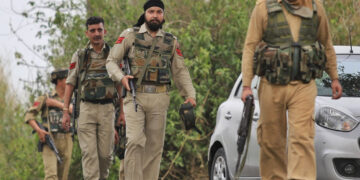 In a bold statement against misinformation, Prime Minister Narendra Modi visited the Adampur Air Base in Punjab today, directly addressing Pakistan’s false claims that it destroyed India’s S-400 missile system during last week’s cross-border tensions.
In a bold statement against misinformation, Prime Minister Narendra Modi visited the Adampur Air Base in Punjab today, directly addressing Pakistan’s false claims that it destroyed India’s S-400 missile system during last week’s cross-border tensions.
PM Modi shared images of himself standing in front of the fully intact S-400 Triumf system, dubbed “Sudarshan Chakra” by Indian forces, symbolizing precision, speed, and lethal capability. The visit comes days after India concluded Operation Sindoor, a strategic military response to the deadly April 22 terror attack in Pahalgam, Jammu and Kashmir.
“It was a very special experience to be with those who epitomise courage, determination, and fearlessness,” PM Modi said on X. “India is eternally grateful to our armed forces for everything they do for our nation.”
India Counters Misinformation Campaign
The visit to Adampur Air Base—one of the primary targets of Pakistan’s retaliatory strikes—served as a powerful rebuttal to Pakistan Air Force (PAF) claims that it had successfully destroyed India’s advanced S-400 defence system.
In an earlier press briefing, Colonel Sofiya Qureshi dismissed Pakistan’s statements as “entirely false.” According to the Indian Ministry of Defence, the S-400 and BrahMos systems remain untouched and fully operational.
“Pakistan’s claims about damaging our S-400 and BrahMos bases using JF-17 fighters are not only false but part of a broader misinformation campaign,” Colonel Qureshi asserted.
Pakistan had also alleged that multiple Indian airfields—including those in Sirsa, Jammu, Pathankot, and Bhuj—were damaged during its drone and missile counterattacks. India firmly denied these allegations, labeling them as “completely baseless.”
Operation Sindoor: India’s Retaliation
Operation Sindoor was India’s carefully coordinated military retaliation targeting nine terror camps across Pakistan and Pakistan-occupied Kashmir (PoK). The operation, which lasted over four days, included precision drone and missile strikes aimed at degrading terrorist infrastructure.
Satellite imagery released post-strike confirmed hits on eleven Pakistani air bases, including key installations like Nur Khan Air Base near Islamabad and Shahbaz Jacobabad in Sindh. India’s Wing Commander Vyomika Singh detailed that radar centers, command structures, and weapon storage facilities were among the destroyed targets.
“These were calibrated strikes with no intention of civilian harm,” Indian military officials emphasized, reiterating that India’s objective was solely focused on disabling terror and military networks.
S-400: The Game-Changer in South Asia
The S-400 Triumf, developed by Russia’s Almaz-Antey, is among the world’s most advanced long-range surface-to-air missile systems. Capable of neutralizing aircraft, drones, cruise, and ballistic missiles, the S-400 can detect targets up to 600 km away and engage threats at ranges of up to 400 km.

India acquired five S-400 systems under a $5.43 billion deal signed in 2018. The first unit was deployed in Punjab in 2021 to bolster defences along the India-Pakistan and India-China borders. Mounted on mobile platforms and equipped with phased-array radar, the S-400 adds a vital layer to India’s multi-tiered air defence.
“The S-400, or Sudarshan Chakra, embodies India’s resolve to defend its sovereignty with cutting-edge capability,” a senior Air Force official noted.
Ceasefire & Future Outlook
Following the high-intensity exchange, a ceasefire was brokered with U.S. President Donald Trump’s intervention. However, PM Modi, in his national address, issued a clear warning:
“If Pakistan dares to violate the ceasefire again, Operation Sindoor will be reactivated with greater intensity,” the Prime Minister declared, adding that future talks will only revolve around PoK and dismantling terror hubs.
Conclusion
PM Modi’s visit to Adampur and his presence beside the fully operational S-400 missile system sent a strong message—India is not only militarily prepared but also ready to counter false narratives with facts.
In today’s era of hybrid warfare, where misinformation is a key weapon, India has shown it can respond with both precision and clarity. By openly challenging Pakistan’s claims, India reaffirmed its strategic strength and public confidence in its armed forces.
The Prime Minister’s declaration that talks with Pakistan will only concern PoK and dismantling terror networks marks a clear shift in India’s doctrine, prioritizing national security and territorial integrity.
With assets like the S-400 in place and a clear political mandate, India stands firm—committed to peace, but prepared for any threat.
















